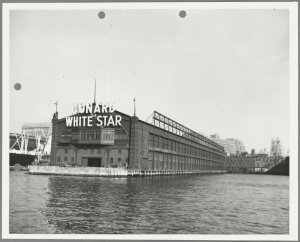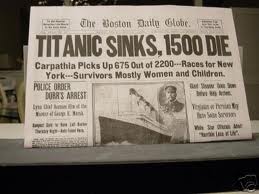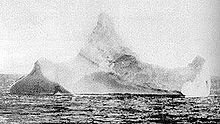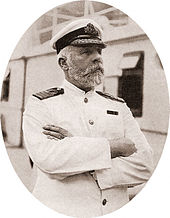Archive for the ‘1912’ Tag
On April 18, 1912 Carpathia docked at Pier 54 in New York with the Titanic survivors. They arrived after dark, and were greeted by a group of thousands. The Travelers Aid Society of New York, the Women’s Relief Committee, and the Council of Jewish Women among other organizations were on hand to provide relief to Titanic’s victims in the form of clothing and transportation to shelters.
Carpathia dropped off the now empty Titanic lifeboats at Pier 59, before unloading the survivors at Pier 54. People were shocked that Titanic could sink with such great loss of life despite all of her technological advances.
The morning after the sinking, the White Star headquarters in Liverpool were filled with press and family members, desperate for word about their relatives. Since the officials were afraid to leave the building because of the emotional crowd, they updated them from the safety of their 4th floor balcony. Newspapers were full of stories and descriptions of the disaster and were on hand to print the very latest updates.

Titanics lifeboats are delivered to the White Star Line pier in New York City.

Pier 54 in New York City
Out of a total 2227 passengers and crew aboard Titanic, only 705 people survived. 3 of the survivors died after being rescued by the Carpathia. These numbers are an estimate, as there are no passenger lists that are believed to be 100% accurate.
I can’t imagine sitting in the water nearby listening to those that were not allowed in a lifeboat die in the freezing water. They wouldn’t have to listen for long, water that cold works in a matter of minutes. Four lifeboats were condensed together and one boat returned to search for survivors.
It is not certain how many were rescued from the water after Titanic sank, but these names have been suggested as potential candidates:
W.F. Hoyt, 1st class passenger
Mr. Fang Lang, 3rd-Class passenger who was found strapped to a door
Steward Harold Phillimore
Mr. Emilio Ilario Giuseppe Portaluppi, 2nd class passenger (there is some debate as to the validity of the claim that this person was rescued from the water.)
Charles Jouphlin, Chief Baker who famously drank enough cooking liquor to keep his blood thin enough to beat hypothermia. In actuality, he was able to climb aboard collapsible lifeboat B and this is most certainly what saved his life. He denied the alcohol rumor until his death.
The lifeboats approach the Carpathia, one at a time until they have all been brought on board. First Office Lightoller is the last survivor to embark on the Carpathia.

Two Titanic lifeboats aproach the Carpathia
April 15, 1912
12:05 am: Orders are given to uncover the lifeboats and prepare the passengers and crew to board them. If every seat on the lifeboats is filled, there is enough room for 1178 passengers. Sadly, there are 2227 on board. The squash court is flooded – 32 feet above the keel.
12:10 – 1:50 am: The Californian is only 10 -20 miles away, and several of her crew members report seeing Titanic’s lights. They also report seeing her distress rockets go up, but because they seem low and make no sound, they show no concern. Titanic sends messages to the Californian via morse lamp, but they never respond. The ships move further and further apart until they can no longer see each other. Sadly, had the Californian taken the distress rockets or the morse code message seriously, they could have saved many lives.
12:15 – 2:30 am: Many nearby ships hear Titanic’s distress signals.
The Olympic (Titanic’s sister ship) is 500 miles away
The Mount Temple is 49 miles away
The Frankfort is 153 miles away
The Birma, is 70 miles away
The Baltic is 253 miles away
The Virginian is 170 miles away
and the Carpathia is 58 miles away.
12:15 am: The band plays lively tunes in the 1st class lounge, to keep the passengers spirits up and to prevent a panic. Later, they move up to the boat deck near the entrance to the grand staircase.
12:20 am: The order is given, and the crew begins to load women and children into the lifeboats.
12:25 am: The Carpathia is southeast of Titanic’s position, and is heading full speed to assist.
12:45 am: The first lifeboat to be lowered is #7, and although it can carry 65 people, it leaves with only 28 aboard. The first of 8 distress rockets are fired. Fourth Officer Boxhall sees a vessel approach Titanic and then turn away, despite their attempts to message the ship via morse lamp. Lifeboat #4 begins loading passengers sometime between 12:30 and 12:45.
12:55 am: The first lifeboat launched from the port side is #6, and it is launched with only 28 aboard including Molly Brown. Lifeboat #5 is lowered, and launched with only 41 aboard.
1:00 am: Starboard lifeboat #3 is lowered with only 32 aboard, including 11 crew members.
1:10 am: Starboard lifeboat #5 is lowered with only 12 aboard, even though its capacity is 40 people. On this lifeboat are 7 crew members, Lady Duff Gordon and Sir Cosmo, among others. The port side lifeboat #8 is lowered with only 39 people on board and is being steered by none other than the Countess of Rothes.
1:15 am: The water reaches Titanic’s name on the bow and she is listing badly on the port side. The tilt of the deck grows steeper. The lifeboats are now being launched more fully loaded.
1:20 am: The starboard lifeboat #9 is lowered with 56 people on board. The list is now to starboard, and quite noticeable.
1:25 am: The port side lifeboat #12 is lowered with 40 women and children on board, along with 2 seamen. After the Titanic sinks, this boat is tied together with lifeboats #4, #10, #14 and collapsible D, and the survivors are moved onto lifeboat #14 so the other boats can return to pick up passengers who are by then swimming in the freezing water.
1:30 am: The passengers still on the ship being to panic. The port side lifeboat #14 is lowered with 60 people on board, including Fifth Officer Lowe. Some of the passengers are preparing to jump into the already full boat when Lowe fires warning shots into the air. Titanic is still sending out distress calls, and they are getting more desperate. “..We are sinking fast,..” and “..women and children in boats, cannot last much longer…”
1:35 am: The port side lifeboat #16 is lowered with over 50 people on board. The starboard lifeboat #13 leaves with 64 people on board, mostly 2nd and 3rd class women and children. Lifeboat #15 is lowered 30 seconds later, with 70 passengers on board, and is nearly lowered on top of lifeboat #13.
1:40 am: Now that most of the forward lifeboats have been loaded and launched, the passengers begin to move to the stern area, hoping to find more lifeboats there. J. Bruce Ismay boards collapsible lifeboat C with 39 aboard. He will be chastised for this, the rest of his life. The forward well deck is submerged at this time.
1:45 am: The last message from the Titanic was heard by the Carpathia, who is en route to assist the faltering ship. “Engine room full up to boilers.” The port side lifeboat #3 is lowered and leaves with only 25 people on board. Her capacity is 40.
1:55 am: John Jacob Astor is refused entry to lifeboat #4 by Lightoller, and instead sees his wife off safely. The boat is lowered with 25 people on board. In their rush to launch the boat, 20 places on the boat are left empty.
2:00 am: The water level is now only 10 feet below the promenade deck.
2:05 am: There are still more than 1500 people left on the sinking Titanic. Collapsible lifeboat D is one of the last boats. It has room for 47 people. To keep the passengers from rushing the boat, Lightoller waves (and may have fired) his pistol in the air, and crew members surround the lifeboat with their arms locked together. Only women and children are allowed to board, and the boat is lowered with 44 on board. The forecastle head sinks under water, and her decks tilt even steeper.
2:10 am: Captain Smith releases the wireless operators from duty, but they choose to stay and continue sending distress messages. The last message Titanic sent read: ” CQD, CQD MGY (Titanic’s radio call letters) We are sinking fast – passengers are being put into boats. MGY”
2:17 am: Captain Smith announces that it is now “every man for himself” and returns to the bridge. Thomas Andrews is seen alone in the 1st class smoking room, staring off into space. The bow plunges under the water, enabling the trapped collapsible lifeboat B to be released. Father Thomas Byles takes confession and gives absolution to over 100 2nd and 3rd class passengers. The band stops playing at this time, and many passengers and crew jump overboard. The forward funnel collapses, crushing many passengers who were already in the water. Collapsible lifeboat A floats free and 2 dozen people in the water try to hold on to it. It rolls right side up, but is swamped and dangerously overloaded. .
2:18 am: A roar is heard as the moveable objects on the ship crash toward the submerged bow. The ship’s lights blink once more and then go out for the last time. Many of the survivors in nearby lifeboats report that they saw the ship break into two pieces. The bow half sinks under the water.
2:20 am: Titanic’s broken stern section settles back into the water, righting itself for a few minutes. It slowly fills with water and then tilts high into the air, before slowly disappearing beneath the waves. Over 1500 souls were lost in what is called the “greatest maritime disaster in history.”
“The sound of people drowning is something I cannot describe to you – and neither can anyone else. It’s the most dreadful sound – and there’s a dreadful silence that follows it.” (Ms. Eva Hart, Titanic survivor)
3:30 am: The Carpathia sends off rockets which are seen by some of the lifeboats. Her normal speed is 14.5 knots, but she has raced to the Titanic’s aid at 17.5 knots. Lifeboat #14 returns to pick up passengers in the water, but most of them had already died.
4:10 am: Lifeboat #2 is the first one picked up by the Carpathia. Ice is floating all around the disaster area with debris from the Titanic.
5:30 am: The Californian is advised by the Frankfort of the sinking of Titanic, and heads towards the disaster area.
5:30 – 6:30 am: Collapsible A passengers are rescued by lifeboat #14, and collapsible B by lifeboats #4 and #12.
8:30 am: The last lifeboat, #12, is picked up by the Carpathia. Lightoller is the last survivor to come on board. The Californian arrives at the disaster area to search for survivors.
8:50 am: The Carpathia leaves for New York City carrying 705 survivors. An estimated 1522 people were lost in the sinking. J. Bruce Ismay wires White Star’s offices in New York, saying “Deeply regret to advise you Titanic sank this morning after a collision with an iceberg, results in serious loss of life. Full particulars later.”

Headlines announce the fate of the Titanic
On this day, 100 years ago, history was in the making. Titanic has nearly reached her final stop, and the events of this iconic day have been reported and researched over the years. Typed words tend to lack emotion, so I would like to take this opportunity to say that the tragedy about to unfold affects me in a profound way, and I feel so sorry for those that suffered and lost on this night to remember.
9:00 am: The Caronia sends the Titanic a message warning them of ice and icebergs and relays exact coordinates.
10:30 am: Church is help in the 1st class dining area.
11:40 am: The Dutch ship Noordam sends a message to Titanic reading “much ice” in nearly the same coordinates the Caronia reported.
12:00 pm: Titanic’s officers conduct a meeting on the bridge to calculate their position and determine how far they have travelled using sextants. They have travelled 546 miles since noon the previous day.
1:42 pm: The Baltic reports “large quantities of field ice” along with the coordinates, while they are about 250 miles ahead of the Titanic on their crossing. This message is later handed to J. Bruce Ismay by Captain Smith, who puts the message in his pocket.
1:45 pm: The German liner Amerika reports “large iceberg” and its exact coordinates of 41° 27’ N, 50° 8’W. This message would never arrive on the bridge because the Marconi radio operators were busy sending messages from the passengers.
5:00 pm: Over the next few hours, the air temperature drops to around 33° F.
5:50 pm: Captain Smith alters the ship’s course a few degrees, turning slightly south and west of the projected course. This may have been in response to the numerous ice / iceberg warnings he received.
6:00 pm: Chief Officer Wilde is relieved of his post on the bridge, taken over by Second Officer Lightoller.
7:15 pm: The forward forecastle hatch is ordered to be closed by First Officer Murdoch. He was concerned that the glow from inside would hinder the watch from the crow’s nest above. The binoculars they would normally use are locked inside a cabinet that no one has a key for.
7:30 pm: The Californian sends 3 messages about large icebergs along with their coordinates of 42° 3’N 49° 9’ W. The message was delivered to the bridge, but it is unknown if Captain Smith was informed because he was attending a dinner party at the time. The ice field is now only 50 miles ahead of the Titanic.
8:40 pm: An order is given by Second Officer Lightoller to watch over the fresh water supply, as the seawater is now hovering just above freezing.
8:55 pm: Captain Smith leaves his dinner party and reports to the bridge. He discusses how calm and clear the weather is with Second Officer Lightoller. They also discuss the visibility of icebergs at night.
9:20 pm: Captain Smith retires to his room, leaving behind an order to wake him “if it becomes at all doubtful…”
9:30 pm: Second Officer Lightoller sends a message to the lookouts in the crow’s nest to watch carefully for icebergs until morning.
9:40 pm: The Mesaba sends out a heavy ice pack and iceberg warning, reporting the location at latitude 42° N to 41° 25’ N longitude 49° W to 50° 30’ W, but these messages are once again overlooked. Combining all the warnings that Titanic received that night, the ice field is nearly 80 miles long and directly in their path.
10:00 pm: Second Officer Lightoller is relieved by First Officer Murdoch and the lookouts in the crow’s nest are relieved by Fredrick Fleet and Reginald Lee. At this time the temperature is 32° F the sky is cloudless and the air is clear.
10:30 pm: The sea water temperature drops to a freezing 31° F.
10:55 pm: 10 – 20 miles north of the Titanic, the Californian is stopped in the ice field and sends out warnings to all ships in the area, including Titanic. When the Californian’s wireless operator calls Titanic, his ice warning is interrupted by the comment, “Keep out! Shut up! You are jamming my signal. I’m working Cape Race.” The operator aboard the Californian listens to Titanic’s wireless traffic for a bit, and then turns his radio off at 11:30 pm, and goes to bed. This is standard procedure.
11:30 pm: The lookouts in the crow’s nest, Fleet and Lee, see a haze appearing directly in the path of Titanic.
11:40 pm: Lookouts in the crow’s nest see an iceberg right ahead, 500 yards away. It is huge, about 60 feet above the water line. Titanic is traveling at 20.5 knots at the time. The lookouts ring the warning bell with three rings and call down to the bridge. They report, “Iceberg right ahead!” Sixth Officer Moody is on bridge and acknowledges the warning and relays the information to First Officer Murdoch who calls for “Hard a starboard” to the helmsmen, and orders the engines to stop, and then “full astern”. Murdoch activates the water tight doors. After several seconds, the ship beings to turn to port, but they strike the iceberg on the starboard bow. The impact was felt by most of the crew in the forward area of the ship, but most of the passengers don’t notice. 37 seconds have elapsed from the sighting of the iceberg, to the collision.
11:50 pm: Within 10 minutes, the water is already 14 feet above the keel, and forward. The first five compartments (with the watertight bulkheads) begin to take on water. Boiler room #6 is already flooded to the 8 foot mark.
12:00 am: The mail room begins to take on water, 24 feet above the keel, enough for the bags of mail to float. Captain Smith, who is now on the bridge, receives reports of water pouring into number 1, 2, and 3 holds, and boiler room #6. He surveys the damaged areas with Thomas Andrews, one of the ship’s architects. Andrews calculates that the ship can stay afloat for only 1 to 2 – 1/2 hours. This is because more than 4 holds are breached, and the water will continue to spill over into the next compartment until all the compartments are flooded. This is the moment in which the gravity of the situation hit the men and they were aware of the tragedy that awaits the ill-fated ship. The bow of the ship begins to sink. Captain Smith sends out the message “CQD” via wireless, which is the distress call of the time (SOS wasn’t used until much later.) Titanic’s estimated coordinates at this time are 41° 46’ N, 50° 14’W. The boilers shut down, and the relief pipes begin to blow off steam, which is quite loud.

This could be the iceberg the Titanic struck
Morning: Capt. Smith takes Titanic through some additional practice turns on her way to Queenstown to test her maneuverability.
11:30 AM: Titanic drops anchor in Queenstown harbor, about two miles out. 113 3rd class and seven 2nd class passengers come on board from tenders, along with 1385 bags of mail. Seven lucky passengers leave the Titanic.
1:30 PM: The anchor is raised for the last time and Titanic leaves on her first (and last) Atlantic crossing, headed for New York harbor. The estimated number of souls on board is somewhere around 2227. (The exact total is unknown because of discrepancies in the passenger & crew counts.)

Captian Edward J. Smith





